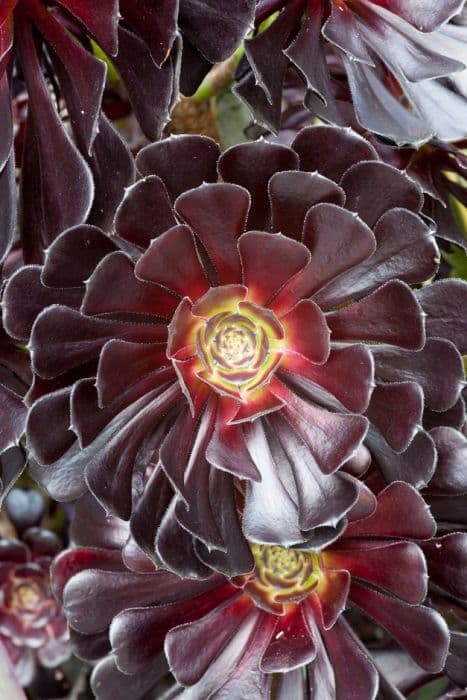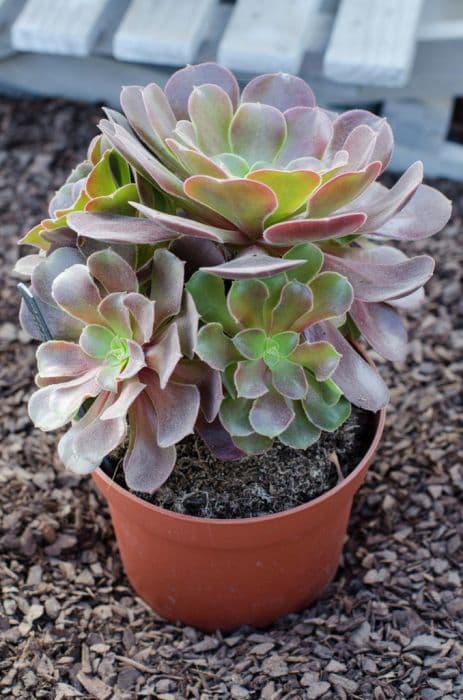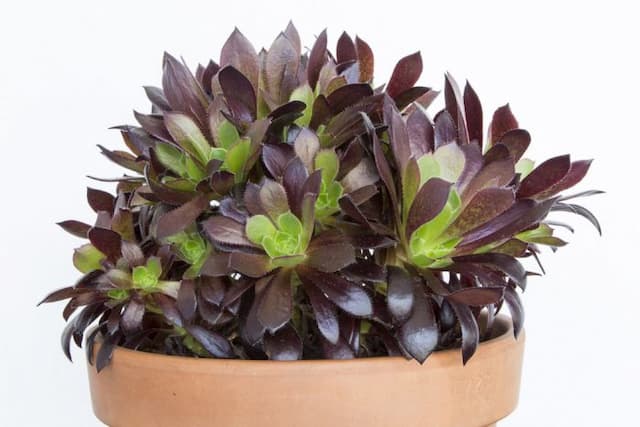Hens and Chicks Sempervivum pittonii

ABOUT
The plant in question is commonly known as houseleek. This succulent forms attractive rosettes of fleshy leaves that are often green with red-tipped edges, creating a vibrant and colorful display. The leaves are thick and have a pointed shape, contributing to the plant's geometric and symmetrical appearance. During its blooming period, it may produce flower stalks bearing star-shaped flowers, adding an extra dimension to its visual appeal. The overall look of the houseleek is one of hardiness and low maintenance, making it a favorite among gardeners and enthusiasts of drought-tolerant plants. Despite its compact form, it can spread over time, creating a dense mat of rosettes that serves as an excellent ground cover or addition to rock gardens and containers.
About this plant
 Names
NamesFamily
Crassulaceae
Synonyms
Pitton's Houseleek, Pitton's Hens and Chicks
Common names
Sempervivum pittonii
 Toxicity
ToxicityTo humans
Sempervivum pittonii, commonly known as Hens and Chicks, is not considered toxic to humans. Therefore, accidental ingestion of this plant typically does not result in poisoning or serious health consequences. However, it's always advisable to avoid consuming plants not meant for human consumption as individual reactions can vary.
To pets
Hens and Chicks, the common name for Sempervivum pittonii, is also not known to be toxic to pets. Ingesting the plant should not cause any significant symptoms of poisoning in animals such as dogs or cats. As with humans, it's generally best to prevent pets from eating non-food plants because individual reactions can occur.
 Characteristics
CharacteristicsLife cycle
Perennials
Foliage type
Evergreen
Color of leaves
Green
Flower color
Red
Height
0.5 feet (15 cm)
Spread
0.5 feet (15 cm)
Plant type
Succulent
Hardiness zones
5
Native area
Europe
Benefits
 General Benefits
General Benefits- Low Maintenance: Sempervivum pittonii, commonly known as Hens and Chicks, requires minimal care, making it ideal for gardeners of all skill levels.
- Drought Tolerant: This succulent is highly drought-resistant, needing only infrequent watering, perfect for xeriscaping or arid climates.
- Cold Hardy: Hens and Chicks can survive in cold temperatures, making it a suitable choice for outdoor gardens in various climates.
- Easy Propagation: The plant produces offsets (chicks) that can be easily replanted to propagate new plants, offering an economical way to expand your garden.
- Versatile Planting: It can be planted in rock gardens, containers, green roofs, and as ground cover, providing flexibility in landscaping.
- Attractive Aesthetic: With its rosette shape and sometimes colorful leaves, it adds visual interest and texture to garden spaces.
- Pest Resistant: Hens and Chicks are not prone to many pests, reducing the need for pesticides and making it a more environmentally friendly choice.
 Medical Properties
Medical PropertiesThis plant is not used for medical purposes.
 Air-purifying Qualities
Air-purifying QualitiesThis plant is not specifically known for air purifying qualities.
 Other Uses
Other Uses- Sempervivum pittonii, also known as Houseleek, can be used as a natural fire retardant due to its succulent nature, which makes it quite resistant to burning.
- Houseleek leaves are sometimes used as a substitute for aloe in soothing minor burns or sunburns, as they contain similar mucilaginous substances.
- The fibers of Sempervivum pittonii can be woven into a durable fabric for creating small pouches or eco-friendly containers.
- Its natural ability to retain water makes the Houseleek a practical planting choice for green roofing projects, contributing to insulation and reducing runoff.
- Houseleeks can be employed in landscaping as a living mulch to suppress weeds and retain soil moisture in garden beds.
- The leaves of Sempervivum pittonii can be used as a protective layer when packing fragile items, acting as a cushion against impact.
- Leaves of the Houseleek may serve as emergency water sources in survival situations since they hold moisture effectively.
- As a decorative element, Houseleeks can be grown in intricate patterns in rock gardens or terrariums to create living art installations.
- These plants serve as an ideal teaching tool for children and beginners in gardening, providing an understanding of succulent care and propagation.
- Houseleeks can be used as a biological indicator for outdoor environmental conditions, with changes in color and form signaling temperature and humidity shifts.
Interesting Facts
 Feng Shui
Feng ShuiThe Hen and chicks is not used in Feng Shui practice.
 Zodiac Sign Compitability
Zodiac Sign CompitabilityThe Hen and chicks is not used in astrology practice.
 Plant Symbolism
Plant Symbolism- Resilience: Sempervivum pittonii, commonly known as Hens and Chicks, symbolizes resilience due to its ability to thrive in poor soil and harsh conditions.
- Protection: This plant is often associated with protection as it has been traditionally used on roofs to guard against lightning and fire.
- Endurance: Its capacity to endure and survive in challenging environments makes it a symbol of endurance.
- Perseverance: Hens and Chicks represents perseverance, as it continues to grow and multiply, even when uprooted or broken apart.
- Vitality: With its evergreen nature and constant growth, the plant stands for vitality and the persistence of life.
- Maternity: The name "Hens and Chicks" reflects the mother plant with its offshoots, symbolizing motherhood, care, and nurturing.
 Water
WaterHens and Chicks should be watered infrequently, allowing the soil to completely dry out between waterings. During the growing season in spring and summer, watering approximately once every 7-10 days with about a quarter to half a gallon for a medium-sized pot should suffice, ensuring you adjust for climate conditions—less water may be needed if it’s rainy or humid. In winter, reduce watering frequency to once a month or less, since the plant enters a dormant period and requires even less water. Always water directly at the base of the plant to avoid water trapping in the rosettes, which can cause rot.
 Light
LightHens and Chicks thrive in full sun to partial shade conditions, benefitting from at least 6 hours of direct sunlight each day. The ideal spot would be a south-facing or west-facing location where it can get ample sunshine. If grown indoors, a sunny window sill where the plant can bask in sunlight for the majority of the day is preferable.
 Temperature
TemperatureHens and Chicks are hardy and can withstand a wide range of temperatures; they can survive in temperatures as low as -20°F and as high as 90°F. However, the ideal growth temperatures for these plants are between 65°F and 75°F. They are well-suited to outdoor life in most temperate climates but should be protected from extreme heat and frost.
 Pruning
PruningHens and Chicks benefit from occasional pruning to remove dead leaves or spent flower stalks, which encourages healthier growth and prevents rot. Pruning is typically done in the spring or early summer, removing any dead material at the base of the plant gently by hand or with clean, sharp scissors. Pruning is not needed frequently—once a year is often ample to keep the plant looking its best.
 Cleaning
CleaningAs needed
 Soil
SoilThe best soil mix for Hens and Chicks (Sempervivum pittonii) should be well-draining, with a mixture of potting soil, coarse sand or perlite, and peat or pine bark. Aim for a soil pH slightly acidic to neutral, around 6.0 to 7.0.
 Repotting
RepottingHens and Chicks (Sempervivum pittonii) should be repotted every 2-3 years or when they outgrow their current container to allow for fresh soil and room for growth.
 Humidity & Misting
Humidity & MistingHens and Chicks (Sempervivum pittonii) thrive in low to average humidity conditions and do not require high humidity levels to grow successfully.
 Suitable locations
Suitable locationsIndoor
Place Hens and Chicks in bright light indoors.
Outdoor
Plant in full sun to partial shade outdoors.
Hardiness zone
4-8 USDA
 Life cycle
Life cycleSempervivum pittonii, commonly known as Hens and Chicks, begins its life cycle as a seed, which germinates in spring or early summer, given appropriate moist conditions and warm temperatures. The seedling emerges and develops into a rosette, the plant's primary growth form, characterized by tightly packed leaves that store water and nutrients, allowing it to thrive in its native rocky, alpine environments. As the plant matures, it produces offsets, or "chicks," which are small rosettes that grow at the base of the parent plant, also known as the "hen." These chicks can eventually detach and root independently, contributing to the spread of the plant. After several years, the hen will produce a flower stalk, during which it blooms with star-shaped flowers, usually pink or red, signaling the reproductive phase. Once it flowers, the original rosette, or hen, typically dies, but the cycle continues as the chicks grow and eventually repeat the process.
 Propogation
PropogationPropogation time
Spring-Early Summer
Sempervivum pittonii, commonly known as a type of houseleek, is propagated typically during the spring or early summer. Among its various methods, the most popular is through offsets. Houseleeks produce small offsets or "pups" at the base of the parent plant, which can be gently removed and replanted to grow new plants. To propagate, wait until the offsets have formed a good root system, which ensures they can sustain themselves when detached. Using a sharp, clean knife or scissors, carefully separate the offsets from the mother plant, ensuring that each offset has some roots attached. The offsets can then be placed on top of well-draining soil and lightly pressed into the surface; avoid watering immediately to prevent rot. After a few days, water sparingly, providing just enough moisture to keep the soil slightly damp, and within a few weeks, they should establish themselves and start growing into new houseleeks.









